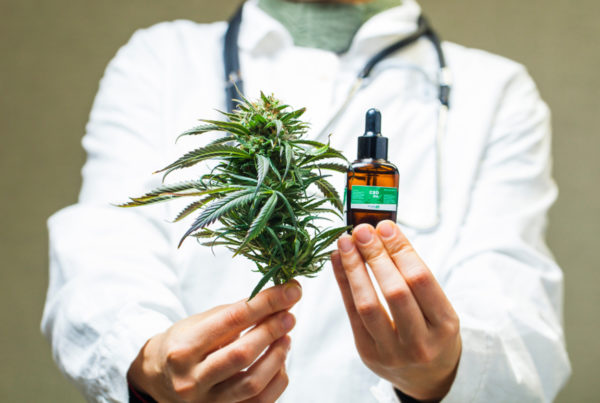Altria’s foray into the marijuana industry is your ticket to living the high life
For all of human history, everyone from ancient hunter-gatherers to modern night club revelers have delighted in getting high.
Whether it’s the intense high of hallucinogens and amphetamines or the mellow buzz of nicotine and caffeine, you can find people just about anywhere intoxicating themselves in some way, shape, or form.
However, drugs have gained a terrible reputation throughout the last century, many of which have been deemed illegal.
Perhaps the best example here at home is President Richard Nixon’s War on Drugs in 1969. His pledge? To rid the country of the insidious narcotics that were said to be ravaging the American people.
The agents, policies, and actions of the War on Drugs were brutal toward anyone involved in the drug trade — both on the distribution and consumption ends. Throughout the years, the campaign has been singularly characterized by its punitive nature.
Foes of the War on Drugs have long protested its methods as draconian, citing its lack of nuance and focus on punishment rather than rehabilitation, especially for non-violent users and offenders. In 2011, the Global Commission on Drug Policy released a report, stating that the global war on drugs has failed, with devastating consequences for individuals and societies around the world.” Ultimately, the War on Drugs failed for the same reason Prohibition failed in the 1930s: Inebriation is part of human nature and society’s laws are not strong enough to prevent it. And there’s another reason the War on Drugs failed… One that’s made a major splash in the news cycle for the past few years. Scientists across the globe have found that some drugs are not as dangerous as they have been made out to be — and even have some promising medicinal properties. The most well-known of these drugs? Marijuana. Now, thanks to widespread acceptance and understanding, the marijuana industry has experienced unprecedented growth.
This month we’ll break down how a tiny green plant blossomed into a billion-dollar industry. I’ll also lay out a strategy you can use to profit.
A Budding Industry That Continues to Grow
Leading scientists now believe that CBD and other non-psychoactive cannabinoids found in marijuana may hold the key to treating a whole slew of illnesses — including cancer, diabetes, anxiety, and depression, to name a few.
In a study published by the European Journal of Pain, researchers applied a CBD-based ointment on rats with arthritis for just four days. Upon observing the rats for this short period, the researchers noted a significant drop in inflammation and indications of pain.
In another study published by the National Center for Biotechnology Information (NCBI), researchers found that CBD-based oil could modestly reduce the levels of spasticity in a person who has multiple sclerosis (MS).
And in the same NCBI study, researchers determined that there was substantial evidence that CBD is an effective treatment for chronic pain sufferers. Studies in a lab are one thing. It’s a whole other ballgame when real people, suffering from real pain, are positively affected by the drug. In the 2013 CNN documentary Weed, Dr. Sanjay Gupta told the story of Charlotte Figi, a 6-year old girl who suffered from Dravet syndrome, causing her to have over 300 epileptic episodes per week. After trying everything from acupuncture and toxifying drugs like Ativan, Valium, and Vivitrol — all of which nearly killed her — Charlotte’s parents turned to CBD. After a short period of CBD use, Charlotte went from having nearly hourly seizures to only around two-three seizures per month. The results, though not backed by FDA-approved medical science, were undeniable.
And all of this evidence has led to widespread adoption. In the U.S., marijuana legalization is handled at the state level. Here’s where we currently stand: • 33 states have legalized medicinal marijuana • 10 states have legalized recreational marijuana • 13 have decriminalized its use. If the momentum continues, which I believe it will, it’s likely that all 50 states will allow the use of marijuana in some manner in the near future. Of course, medical patients, marijuana growers, and college students alike will rejoice. And the implications for investors are even greener…
Work Smarter, Not Harder
Like any up-and-coming industry, there will be volatility.
For the hundreds of start-ups that will blast onto the scene to take advantage, only a small percentage will actually survive.
Instead of investing in a company that manufactures marijuana… We’ll invest in a well-established company from another industry that’s finding inventive ways to profit off cannabis for itself. This extremely low risk/high return company has already been making people rich for decades… long before the cannabis revolution took hold.
The company in question? Altria (NYSE: MO).
The No. 1 Vice Stock in America
Altria is a vice products powerhouse, housing brands including Philip Morris USA, John Middleton, and U.S. Smokeless Tobacco Co. You may know it best from brands such as Marlboro cigarettes, Copenhagen, and Skoal smokeless tobacco. In addition to its standard tobacco products, Altria also has its hands in the alcobev space, owning Ste. Michelle wines and about a 10.1% stake in alcobev titan ABInBev. Now, on the whole, cigarette sales volume has been shrinking. New research and several cunning ad campaigns have deterred people from continuing with the habit.
However, one look at Altria’s annual 10-K report proves that the company has been resilient. Even with shrinking tobacco sales, Altria’s revenues have remained constant since 2014 at approximately $25 billion.
The company has been strategic in investing heavily in the future of smoking: E-cigarettes and marijuana.
The Crown Juul of the E-Cigarette Trend
Electronic cigarettes have taken the world by storm, introducing “vaping” as a major cultural trend.
Purported to be a healthier alternative to traditional cigarettes, e-cigarettes use electricity from a small battery to vaporize flavored liquid that contains nicotine, giving users the same feeling as smoking with fewer carcinogens. In December 2018, Altria entered the e-cigarette business with its 35% acquisition of Juul, the industry leader with over 75% market share. With the $12.8 billion price tag, Juul is now valued at a whopping $38 billion. To put that into perspective, Juul is now worth more than Ford Motor Company (NYSE: F), Kroger (NYSE: KR), and Twitter (NYSE: TWTR). Despite a few setbacks — including regulators banning Juul from advertising directly to younger generations — vaping has a serious following. And despite Juul’s already-massive market share, the opportunities it offers have just barely begun to emerge.
A Cunning Move into Cannabis
The traditional tobacco market, worth $108 billion in the U.S, is highly valuable. The e-cigarette market, expected to be worth $47 billion in the U.S. by 2025, is highly promising.
But these markets don’t hold a candle to what may come from the burgeoning marijuana market.
Consider this: The pharmaceutical market in the U.S. currently sits at $450 billion. That’s larger than the alcohol and tobacco industries combined.
When marijuana begins to replace top-selling drugs for pain management (think: opioids), companies across the marijuana value chain will begin to reap major financial gains.
And Altria is acutely aware of this. Which is why it set itself up to take a piece of the pie.
In December 2018, Altria acquired 45% of Cronos Holdings for $1.8 billion. Cronos Holdings is a Canadian marijuana company, offering its products through two recreational marijuana brands (Cove and Spinach) and its medicinal marijuana brand (Peace Naturals).
Cronos has also penned a partnership worth up to $100 million with Ginkgo Bioworks, to utilize Ginkgo’s proprietary organism design technology. This technology can be used to grow yeast strains capable of facilitating large-scale cannabinoid production. Ginkgo has the ability to grow, harvest, and concentrate cannabinoids that are too weak to use when naturally occurring. This will enable the company to make a truly unique product. While the competition continues to play in the highly saturated THC and CBD oil market, Altria will be able to offer truly one-of-a-kind products to consumers with the help of Cronos and Ginkgo. Between tobacco, alcohol, e-cigarettes, and now marijuana, Altria has created the perfect storm for long term growth in the vice industry.
Altria the Superpower
Altria’s traditional tobacco brands satisfy investors because of its consistent revenues and strong profit margins.
Juul’s vaping products excite investors because of the industry’s growth potential.
Cronos’ products thrill investors because of the company’s strong position in the soon-to explode recreational and medicinal marijuana industries.
Each of these brands makes for strong investment opportunities on their own. I, however, am excited by the synergy between them.
Juul and Cronos have both been exceedingly successful in their respective spaces, but now that portions of each are under the same roof at Altria, there is an opportunity for some cross-pollination. In the past few years, vaping marijuana has exploded.
Due to the convenience and health benefits, many traditional marijuana users have laid down their old school joints and blunts in favor of Space Age looking weed pens and vaporizers.
With Cronos’ expertise in marijuana and Juul’s trendsetting marketing team, Altria could reap major rewards from facilitating a Juulbranded marijuana vaping product.
Plus, Altria has the power of experience on its side.
You see, Altria boasts 100-plus years of operational excellence.
Altria’s tobacco products are distributed to hundreds of thousands of points of sale around the world.
This is a distribution network that has literally taken Altria over a century to develop. No start-up marijuana company can compete with those kinds of connections.
Combining Altria’s distribution network and resources with Cronos and Juul’s products, marketing, and IP undoubtedly offers investors far more than the sum of its parts.
This is what makes Altria — a traditionally tobacco-based company — the ideal backdoor play on the budding marijuana industry.
Your Weed-tirement Opportunity
If at this point you’ve pulled out your smartphone and opened ETrade, TD Ameritrade, or whatever trading platform you use, you’re on the same page as me.
I suggest treating the purchase of Altria stock as a long-term investment — with an eye toward retirement.
The reason is simple. The e-cigarette and marijuana industries are in their infancy right now. But they will be massive. I want your investment in Altria to grow alongside these industries — and ultimately serve as a nice nest egg.
Imagine if you had the opportunity to invest in the alcobev industry in the 1930s right after Prohibition ended. You would have made an absolute fortune.
Marijuana and vaping are this generation’s opportunity to cash in at the ground floor. And better yet, Altria allows you to invest in both in one fell swoop!
Action to Take: Buy Altria (NYSE: MO) at market prices up to $61 — and on dips to $45. And reinvest all dividend payments.






